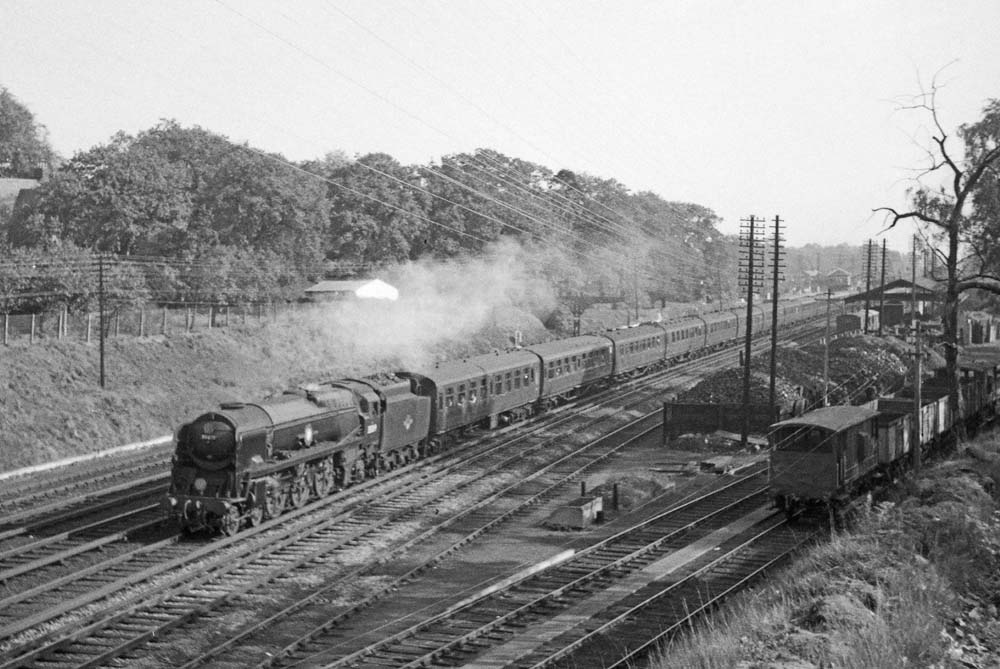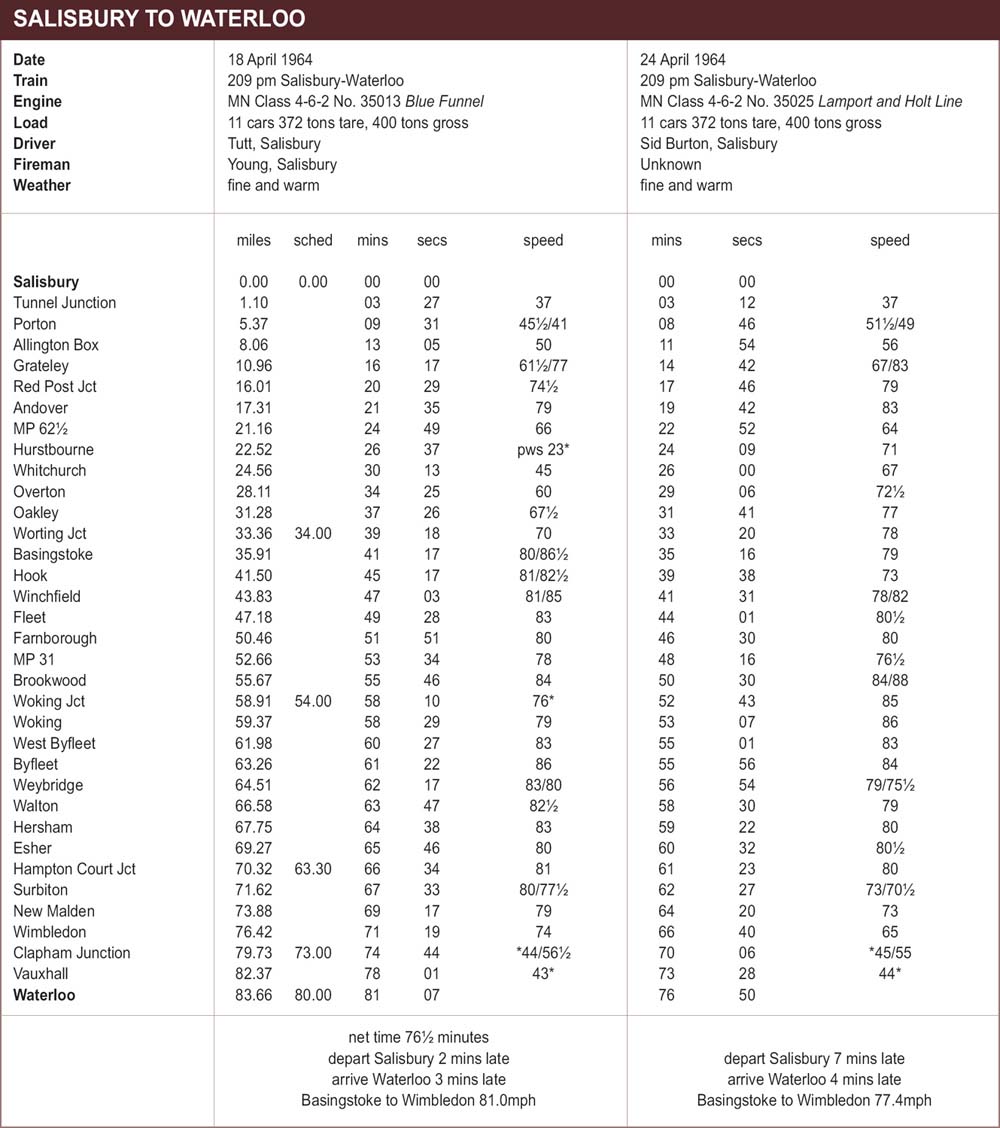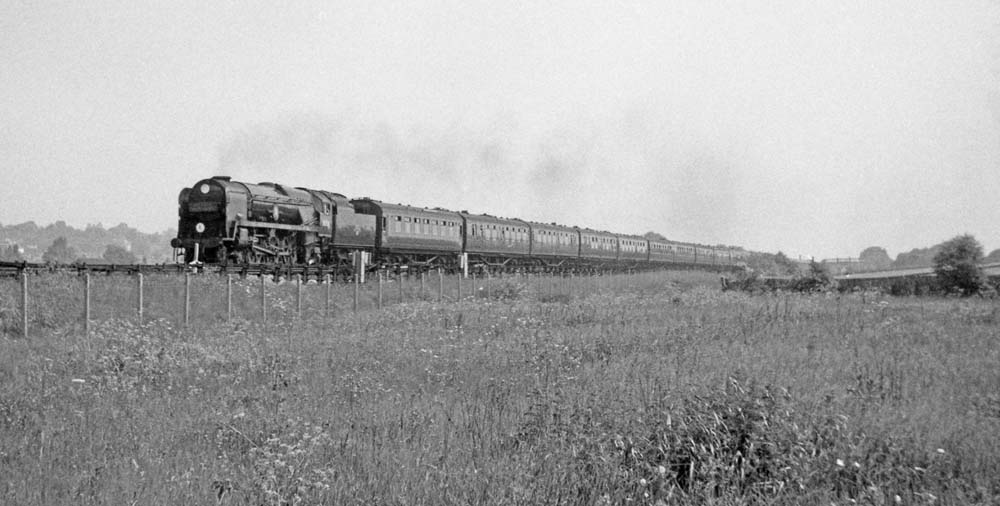

19 May 1964. Charlie Hopgood takes the 11 am from Waterloo out of Salisbury with 35028 Clan Line.
“These enginemen produced some very fine performances from their steeds, with good timekeeping a point of honour”

10 July 1963. 35009 Shaw Savill approaching Clapham Junction with the up ACE.
1964 was the last year of the famous Atlantic Coast Express (ACE) which ran from Waterloo to Exeter and beyond. This coincided with the transfer of the lines west of Salisbury from the Southern to the Western Region, the latter then doing its best to completely destroy the use made of the line by singling most of it and reducing the train service to a minimum. The ploy didn’t work and now the line prospers and double track has been partly reinstated, most recently south of Chard Junction to Axminster.
In the 1960s for most of the year the ACE ran in one portion from Waterloo at 11 am, fast to Salisbury, then non-stop to Sidmouth Junction and Exeter Central. There the train would divide, with portions for Ilfracombe and Padstow. The up train, due at Waterloo at 3.29 pm, mirrored this arrangement and had the same timings over the two fastest sections. For three or four weeks at the height of the summer the train ran in two portions to and from Waterloo and Exeter, with the second down train at 11.05 am and the extra up train arriving at 3.21 pm. On summer Saturdays the train ran in five portions for all or part of the summer timetable, with Waterloo departures at 10.15, 10.35, 11.00, 11.15 and 11.45.
The accompanying table shows the motive power on these trains on 21 July 1962. This pattern continued right to the end of the summer timetable on 5 September in the last year of the ACE, 1964.


23 July 1962. 35014 Nederland Line at Waterloo on the down ACE.
In the final three years the train was timed over the 83.7 miles to Salisbury in 80 minutes, and then 75 minutes (reduced to 73 minutes in 1964) for the 75.9 miles to Sidmouth Junction, making it the fastest booked steam hauled train on BR. With a load of 11 to 13 coaches it was booked for Merchant Navy haulage and for the last few years was worked both ways, between Waterloo and Salisbury by Salisbury men, and west of Salisbury by Exmouth Junction crews. These enginemen produced some very fine performances from their steeds, with good timekeeping a point of honour. I had many runs on the ACE, mostly between Waterloo and Salisbury and never had a bad run in the last two years. Time recovery from late running caused by delays earlier on the down runs could result in some quite fantastic performances from the Merchant Navy Pacifics. For instance on 30 May 1964 a signal failure at New Malden plus a late departure and a signal check at Tunnel Junction meant that 35012 on twelve coaches for 445 tons was 6 minutes late at Woking and 5 minutes late into Salisbury. Here Driver Cook and fireman Smith from Exmouth Junction took over and converted an 8 minute late departure into just 4 minutes late at Exeter. The time from Salisbury to Sidmouth Junction was just 71 minutes and 40 seconds with running of the highest quality throughout. The maximum speeds were 85 at Gillingham, 88 before Templecombe, 90 at Sherborne and 85 past Axminster. Honiton bank was climbed with a sustained minimum of 38mph, very good going with this load. The final dash from Sidmouth Junction produced another 90 through the woods at Broad Clyst. Even better was on 29 February 1964 when driver Besley of Exmouth Junction left Salisbury no less than 12 minutes late with 35020 on eleven coaches for 400 tons and reached Exeter just 2 minutes late.
The time from Salisbury to Sidmouth Junction was 69 minutes 38 seconds with some very fast speeds on the downhill sections: 91 at Gillingham, 83 before Templecombe, no less than 96 at Sherborne and 91 at Axminster. Honiton was climbed at a minimum of 41mph, my highest on the ACE. The overall time for the 88 miles from Salisbury to Exeter was a very fine 85 minutes 44 seconds. That was my fastest and included over 2½ minutes standing at Sidmouth Junction.
Before I look at more runs in that last year of 1964 I must mention the Salisbury drivers who covered the train both ways between Waterloo and Salisbury (except on Bank Holidays). During the period 1961 to 1963 the Salisbury top link drivers were:- Doc Allen, Tom Hatcher, Bill Brownscombe, Ernie Pistell, Bert Cambray (always smartly dressed with a bow tie), Dick Hurrell, Walter Clissold, Ted Britten, Fred Hoare, Ed Saunders, Sid Bowden and Percy Young. As some of these retired they were replaced by others from lower links or the spare link and these men also covered for absence from time to time. They included Simms, Phillips, Cox, Tutt, Knight, Sharpe, Hill, Padwick, Hooper, Charlie Hopgood and Sid Burton. I got to know many of the regular drivers quite well, particularly the Salisbury men, most in their last years before retirement. All of these drivers were capable of timing the ACE easily with a Merchant Navy and some could if a Bulleid light Pacific was allocated, which sometimes happened especially on the up train. Others though would take the view that a light Pacific couldn’t do the job and so set out with that in mind and drove the engine as if it were a Merchant which usually resulted in a loss of about three minutes on the schedule between Salisbury and Waterloo. Men like Fred Hoare though relished the prospect of the smaller engine and kept time easily.

11 April 1964, 35024 East Asiatic Company passing Surbiton on the down ACE.
Fred had a particular liking for the unrebuilt engines and reckoned they were freer running than the Jarvis rebuilds, which I agree with and have stated elsewhere. The 80 minute schedule, especially going down, could be kept very easily provided that a good start was made and the climbs to milepost 31, Battledown and Grateley were taken well. Speed barely needed to reach 80 for a timekeeping run and indeed my fastest down run in 76 minutes 4 seconds was done with a maximum speed of 82mph. Although the up train was generally regarded as being the tougher proposition, both Doc Allen and Ed Saunders gave me runs of just under 80 minutes unchecked with a maximum speed of 80mph. True enginemanship with trains running on time.

3 June 1963. 35020 Bibby Line near Pirbright with the down ACE.

12 October 1963. 35019 French Line CGT on the down ACE passing Walton-on-Thames.

I have picked out two 1964 runs each way over the Waterloo to Salisbury section as this is where I did most of my travelling. Both were very fine runs with drivers who came later to the Salisbury top link and both had the normal ‘winter’ load of twelve coaches 435-445 tons full. Both also had exactly the same net time of 76 minutes and were fairly typical of down runs in that last year, showing just how much time a Merchant Navy with a good driver had to spare on the 80 minute schedule. Charlie Hopgood was a very consistent driver and a cheerful character as can be seen from one of the photographs. I had a series of similar runs with him at the regulator. The 85mph overall speed limit wasn’t often exceeded on this stretch even when making up lost time, though it was a different matter after Salisbury, as referred to earlier in the article. Driver Cox would have got us into Salisbury more than minute early on 18 April if it hadn’t been for the signal check at Tunnel Junction, despite the relaying slack at Hurstbourne. Another of the photographs shows 35016 after arrival at Salisbury.

The two up runs tabulated are also typical of what was being done that year, or maybe above par for the course as anything under 78 minutes was considered to be good. On 18 April, having gone down on the ACE we decided to return on the up train and were rewarded with a very good run with one of the spare link drivers, Tutt. The start was quite steady with the engine priming on the climb up Porton bank and it wasn’t until after the relaying slack at Hurstbourne that Blue Funnel really got going averaging exactly 81mph from Basingstoke to Wimbledon, without exceeding 86mph and with an easing to 76mph through Woking. This was one of my fastest times over the 25.55 mile section from Worting Junction to Woking Junction as on many runs the running was only just enough to keep the very tight 20 minute booking which required an average speed of nearly 77mph and a clear road.

13 July 1963. Just west of Woking. The down ACE headed by 35001 passing the 11.25 Woking to Salisbury local headed by 31631.

18 April 1964. 35016 Elders Fyffes at Salisbury after the run described above.

8 June 1963. 35030 Elder Dempster Lines heads the down ACE at Raynes Park.
If you add the time from Salisbury to Worting Junction of the run on 24 April to the time of this run in from there you get an overall time of 75 minutes 9 seconds which wasn’t often achieved in practice. In fact the time of 41 minutes 49 seconds for the 50.30 miles in from Worting Junction was the fastest I ever recorded with steam. 35013 Blue Funnel worked the up ACE a lot in 1964 and I had more runs with this consistently good engine than any other. The 24 April run was timed as part of a week’s Southern Rail Rover and Sid Burton worked the up ACE most of the week. He was a lovely man and a good driver though went better with a bit of encouragement. This was his best run of the week with a very good start and some faster than normal running down past Woking. I suspect he had an eye on the clock and thought he might be able to recover all of the seven minute late start. He didn’t but it was my fastest time of the week and indeed my fastest ever on the up ACE. Sid Burton gave me two other runs on the up ACE that week. On 22 April he had 35013 with the usual eleven coaches for 400 tons. The overall time was 81 minutes 53 seconds with a signal check from the up Salisbury stopper at West Byfleet which we caught again at Wimbledon. Net time was just over 77 minutes, showing consistency with the run on 24 April, and on 23 April Sid had unrebuilt light pacific 34086 on the same load.
We had an unchecked run in 81 minutes 37 seconds, being slower out to Worting but running in from there in 44 minutes 41 seconds, over a minute better than the schedule.
It all came to an end when 35022 worked the last down Atlantic Coast Express on 4 September 1964 and with it the last express train running to mile-a-minute timings. Though I timed many very good runs after that year and before the end of steam on the Southern, the ACE remains the high water mark with so many good runs and memories of those true enginemen, especially the Salisbury men.

9 March 1962. 35025 Brocklebank Line on the up ACE passing Vauxhall.

17 July 1962. Driver Percy Young of Salisbury on 35018 British India Line at Waterloo about to depart on the ACE.